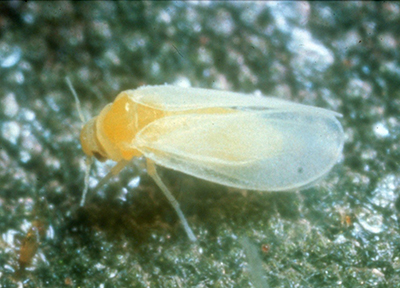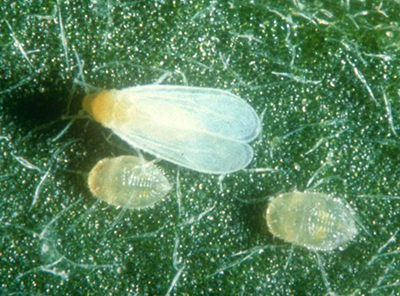Controlling whitefly in the greenhouse
Greenhouse growers need to be vigilant in scouting for whitefly and be aware that some whitefly populations have been prone to develop insecticide resistance.
Recently, there have been reports from the University of Florida that there are now established populations of insecticide resistant sweet potato whitefly (Bemisia tabaci) in Palm Beach County, Florida. There are two major biotypes (identical genetic “strains”) of whitefly: B and Q. The B biotype of whitefly has been in the United States for over 30 years, while the Q biotype only became a problem in the United States within the last 10 years. The Q biotype is much more resistant to conventional control compared with the B biotype. The Q biotype has been found in cotton fields for many years though, and their presence in the whitefly population has come and gone over the years. A very high level of insecticide use is needed for the Q biotype to become dominant. The B biotype usually outcompetes the Q biotype and it still remains the dominant pest whitefly of greenhouse plants.
As always, greenhouse growers in Florida and other parts of the country should be vigilant when scouting their plant material to monitor whitefly populations. For growers opting to use insecticides to control whitefly, MSU Extension recommends the following insecticides for 2016:
- Azadarachtin
- BotaniGuard
- Distance (not for Q biotype)
- Endeavor
- Enstar (not for Q biotype)
- Judo
- Kontos
- Ornazin
- Orthene 97
- Pedestal
- Pyriproxyfen
- Rycar
- Sanmite
- Talus (not for Q biotype)
- Insecticidal soap
- Horticultural oils
- Neonicotinoid: imidacloprid
Growers can also use biological control to manage whitefly populations. There are two commercially available parasitoids in the United States: Encarsia formosa and Eretmocerus eremicus. Eretmocerus eremicus will parasitize both sweet potato and greenhouse (Trialeurodes vaporariorum) whiteflies while Encarsia formosa will only parasitize greenhouse whiteflies. For production during these warmer months, Eretmocerus eremicus is more effective at higher temperatures than Encarsia formosa. There are also two commercially available predators that feed on whiteflies: Amblyseius swirskii and Delphastus catalinae. A. swirkii feeds on the eggs and nymphs of whiteflies while D. catalinae feeds on whitefly eggs.


Left: Sweet Potato Whitefly. Photo: Bugwood.org. Right: Greenhouse Whitefly. Photo: Bugwood.org
If greenhouse growers suspect that they might have whiteflies that are resistant to insecticides, they may want to send a sample to an Extension entomologist to be tested. If growers suspect that they may have the Q biotype of whitefly, which has recently made the news, growers should send samples to Dr. Cindy McKenzie a Research Entomologist at the USDA-ARS in Fort Pierce, Florida. Remember that, unfortunately, both the Q and B biotypes of Bemesia whitefly look identical and growers will not be able to tell them apart until they have experienced failure in controlling them with numerous insecticides.
Growers can read more information about whitefly issues in the landscape on the University of Florida’s Bemisia webpage. For more information about how greenhouse growers can help, read the “Letter to Ornamental Growers from the Ad Hoc Whitefly Task Force.”
For more information on the whitefly biological control agents, check out the MSU Extension and Kansas State University Bulletin E-3299, “Commercially Available Biological Control Agents for Common Greenhouse Insect Pests”.



 Print
Print Email
Email




